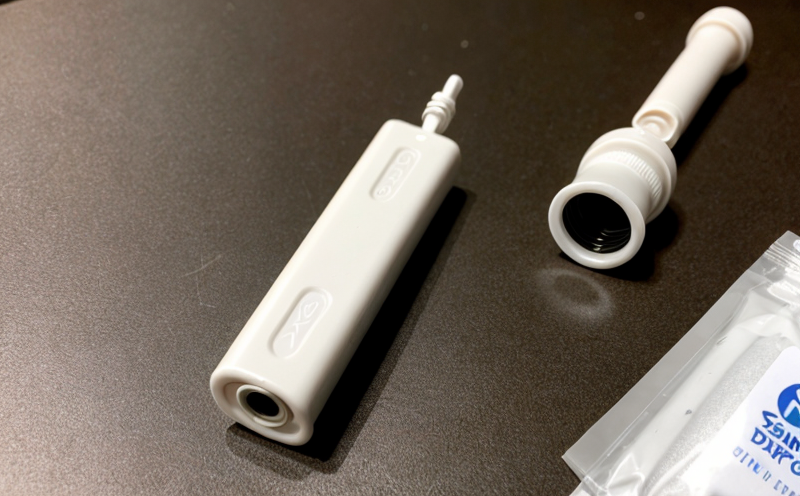ISO 15223-1 Labeling and Symbols Compliance Testing
The International Organization for Standardization (ISO) has established a series of standards to ensure medical devices meet safety, performance, and regulatory requirements. Among these is ISO 15223-1, which provides guidelines on labeling and symbols used in the design and manufacturing of single-use medical devices. Compliance with this standard ensures that critical information is communicated effectively to healthcare professionals, patients, and other stakeholders.
ISO 15223-1 covers several aspects including the requirements for device labels, symbols, and instructions for use. The primary goal is to ensure that all necessary information is clearly visible, unambiguous, and easily understandable in various languages and cultures. This standard applies to a wide range of single-use medical devices such as syringes, catheters, surgical instruments, and other products used in healthcare settings.
The testing process for compliance with ISO 15223-1 involves several steps, including:
- Reviewing the device’s design and labeling to ensure all required information is present.
- Evaluating the clarity and readability of text and symbols used in different languages.
- Checking if the symbols comply with international standards for single-use devices.
- Assessing whether the instructions for use are comprehensive and clear.
Our testing laboratory specializes in ensuring that your products meet these stringent requirements. We utilize state-of-the-art equipment to simulate real-world conditions, providing accurate and reliable results. By partnering with us, you can rest assured that your devices will comply with ISO 15223-1, thereby enhancing patient safety and regulatory compliance.
Our team of experts works closely with clients to understand their specific needs and challenges in the medical device industry. We offer tailored solutions for various stages of product development, from initial design through final manufacturing processes. Whether you require assistance with labeling design or need help ensuring your labels meet all relevant standards, we have the expertise and resources to support you.
By choosing our ISO 15223-1 Labeling and Symbols Compliance Testing service, you are investing in the quality of your products and protecting the health and safety of patients. Our rigorous testing ensures that your devices not only meet but exceed industry expectations, fostering trust and confidence among healthcare providers.
Why It Matters
Compliance with ISO 15223-1 is crucial for several reasons:
- Enhanced Patient Safety: Clear and accurate labeling helps reduce the risk of errors in device use, ensuring that healthcare professionals have all necessary information at their fingertips.
- Regulatory Compliance: Meeting this standard ensures that your products meet international regulatory requirements, facilitating easier market access and reducing the likelihood of recalls or non-compliance issues.
- Patient Trust: Well-designed labels can increase patient confidence in the medical devices they use, leading to better healthcare outcomes.
- Competitive Advantage: Demonstrating compliance with ISO 15223-1 sets your company apart from competitors by showcasing a commitment to quality and safety.
In today’s competitive market, ensuring that your products comply with global standards is essential. By investing in our testing services, you can ensure that your devices not only meet but exceed the expectations of healthcare professionals and patients alike.
Applied Standards
The application of ISO 15223-1 involves several key components:
- Labeling Requirements: This includes the use of specific text, symbols, and instructions for use that are required by the standard.
- Languages and Symbols: The labeling must be in a language or languages understood by the target audience. Symbols used should comply with international standards to ensure they are universally recognizable.
- Instructions for Use: Clear, concise instructions that guide users on how to properly operate the device safely and effectively.
The standard also emphasizes the importance of ensuring that all information is easily accessible and understandable. This includes considering factors such as color contrast, font size, and placement on the label. By adhering to these guidelines, manufacturers can ensure their devices are compliant with ISO 15223-1.
Customer Impact and Satisfaction
The impact of ISO 15223-1 compliance extends far beyond mere regulatory adherence; it significantly enhances the overall experience for both healthcare providers and patients. Here’s how:
- Patient Safety: Clear labeling reduces the likelihood of errors in device usage, thereby enhancing patient safety.
- Regulatory Compliance: Meeting this standard ensures that products meet international regulatory requirements, simplifying market access and reducing compliance risks.
- Patient Trust: Well-designed labels can increase confidence in medical devices, leading to better healthcare outcomes.
- Competitive Advantage: Demonstrating adherence to global standards sets your company apart, enhancing its reputation and competitiveness.
Our testing services not only help you meet these standards but also provide valuable insights into potential areas for improvement. By working with us, you can ensure that your products are not just compliant but optimized for performance and safety.





